Lecture 9 - Part 1
Graphical patterns analysis
This lecture will be devoted to acquaintance with price patterns which forms the market, and rules of their pattern-matching.
It would be a mistake to suppose that any changes in trend dynamics can occur in a moment. Transition period is necessary for major changes on market. Transition periods and their meanings analysis for market forecast brings us closer to the theme of price patterns. First of all, let us define what it is. Price patterns are figure or unit which appear at the stock price or commodity assets’ charts. These figures, or units, are divided into some groups and can be used for market dynamics’ forecast.
All price patterns are divided into two big groups – reversal pattern and continuation pattern. Judging by the name of patterns, first one indicates that important fracture is in the trend dynamics. And pattern of continuing trend testifies that market paused. Probably trend was developing too fast and temporally came into overbought or oversold condition. Then after intermediate correction it will continue its movement to the previous direction. The main nicety here is to distinguish one pattern from another and it should be done as soon as possible, during its forming.
Let us consider reversal pattern first.
Before proceeding to detailed consideration of every major reversal pattern, let us point out some general conditions which are typical for any of these patterns:
- Prerequisite for appearance of any reversal pattern is previous trend.
- The first signal of coming fracture often can be break of important trend line.
- The larger a pattern then more important will be future market movement.
- Top patterns as a rule are more changeable and short in time than bottom patterns.
- Bottom patterns are characterized by less price change and it takes more time for its modeling.
REVERSAL PATTERN “HEAD-AND-SHOULDERS”
Now we are going to dwell upon the most famous and reliable pattern – “head-and-shoulders” pattern. We will pay attention to this pattern not only because it is very important indeed, but also in order to consider all possible nuances connected with reversal pattern analysis. The matter is that the most of other reversal patterns are just variants of “head-and-shoulders” model and do not need such detailed consideration.
This main reversal pattern as others is direct logical continuation and development of the points connected with trend, which we talk about in the last lecture. Imagine the situation where while uptrend consecutively rising highs and downsides are gradually started to slow pace. As a result stagnation appears in uptrend dynamics. At the moment the forces of supply and demand are considered in balance. When this phase ends, support level which undergoes along the horizontal “trading range,” breaks. At this moment downtrend starts. Consequently it is formed by descending highs and downsides.
Let us consider now how reversal scenario will look at the peak of the market, presented by the pattern “head-and-shoulders” (pic. 1 and 2). In A point uptrend continues its development without any insinuation to the top. Prices form new maximum, volume is increasing. Everything is like it should be. Then intermediate downside occurs (point B). In C point accurate analyst notices that trading activeness was lower than in previous uptrend period while price break above A level. This event does not have any importance on its own but alert signal appears in analyst’s mind. Prices start falling down after that till D point and then something more serious occurs. Prices fail to take out the previous peak in A point. Let us remember that while uptrend every previous peak should be as support level relative to the intermediate downsides. It does not happen in our case. Prices fall down the A point almost to the level of previous downsides (point B). It is one more alarm: seems like uptrend is weakened.
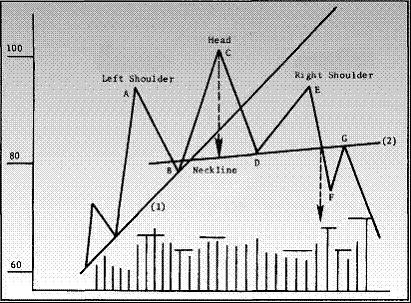
Pic. 1. Pattern example for market top. Left and right shoulders (A and E) are almost at the same level. Head (C ) is higher than any shoulder. Pattern is completed when closing price is fixed below the level of the neckline (line2). Neckline is build from the point B – first downside of pattern formation, through the D point – the second downside. Minimal target can be calculated by measuring the high point of the head to the neckline. While the next price rising return to the neckline but prices are not able to traverse it.
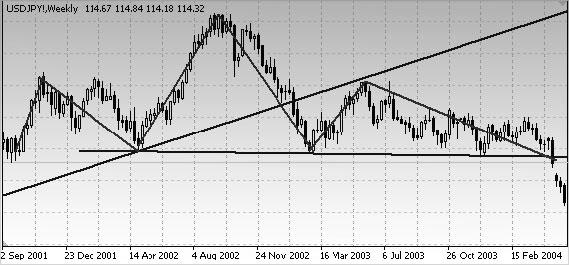
Pic. 2. USD/GPY. Weekly chart. “Head-and-shoulders” top. Pay attention to the three peaks where head is higher than shoulders. The main uptrend line was broken before than right shoulder was formed. Look also to the prices to rise to the neckline after the breakout of the uptrend.
INVERSE HEAD-AND-SHOULDERS PATTERN
Head-and-shoulders bottom or inverse head-and-shoulders is a mirror image of top pattern we have just talked about. At the picture 3 we can clearly see that there is three pronounced downsides, meanwhile head is lower than shoulders. If the neckline was broken by the closing price, pattern is complete. Price targets assessment is made with the same principals as for top patterns. Insignificant distinction is that probability of reverse price movement to the neckline after bullish break is higher in the bottom pattern.
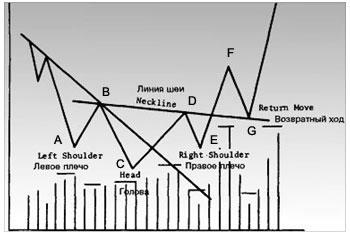
Pic. 3. Inverse head-and-shoulders pattern example. Bottom pattern is a mirror image of top pattern in this case. The neckline is formed from the B point – first peak of figure formation, through the D point. Reversal price movement to the neckline after the break is more typical for the bottom patterns.
Difference here is that market can “fall down” because of inertial force. Demand and purchase requirement absence is enough to urge the market down. However it is impossible to make it move upwards by inertia force. Prices will grow only if demand exceeds supply, if buyers are more active and energetic than sellers.
Price rise from the head point in the bottom pattern should be followed by increase of business activity but often its level exceeds the volume which falls on the previous spike from the left shoulders point. Slope to the right shoulder should lead volume decrease. The most critical moment falls on the break point of the neckline. This signal should be attended by the real explosion of traffic if the break is not false. It is the main difference between the top pattern and inverse pattern, or bottom pattern. For the last pattern large traffic while closing is absolutely necessary component. Reverse price movement is more typical for bottom pattern and should be followed by little trading volume. However while the next restoration of the steady uptrend, volume should rise.
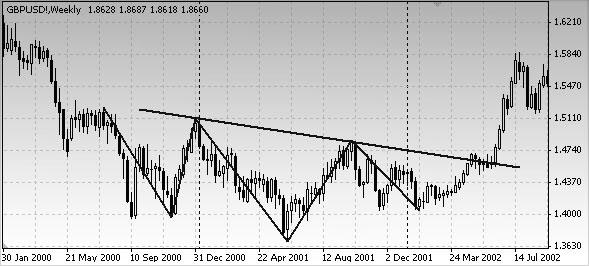
Pic. 4. GBP/USD weekly chart. Head-and-shoulders bottom pattern example. Left shoulder formed in September, right shoulder – in December. Head which formed in April makes up more lower bottom. At the end of March price broke the neckline which has been existed more than one year. So the main bullish signal was given for the market.
For positions opening in top pattern or in bottom one it is necessary to wait until the neckline break. Only after the break of this support or resistance line, pattern is complete. After prices cross the neckline and finished the formation of head-and-shoulders pattern, they should not cross the neckline again. If we have the top pattern then after the neckline was broken down, any following price closing above the neckline is a serious warning that the first break was false. Failed head-and-shoulders patterns appear. At the beginning these patterns look like a classic reversal pattern and then at some development level (before the neckline break or after it) prices suddenly start moving in previous trend.
TRIPLE TOP AND TRIPLE BOTTOM
Many conditions which we were talking about while head-and-shoulders pattern discussion, can be referred to other reversal patterns (pic.5). Triple top and bottom pattern is more rare than head-and-shoulders. Triple top and bottom pattern is just variety of it. The main difference is that all three peaks (or slope) are at the same level in the triple top and bottom pattern (pic. 7). Technical analysts often disagree on what they see: head-and-shoulders or triple top. This argument has mostly academic character because both patterns present almost the same.
Trading volume decreases along with every following peak in top pattern and should increase in the break point. Pattern is not complete until the support levels passing under two previous slopes are not broken. Consequently closing prices should break resistance level passing above the previous two peaks. Only after pattern is complete (as alternative strategy you can consider the closest peak or slope level break as a signal of trend reverse). Very important factor for completing the bottom pattern is trading volume increase.
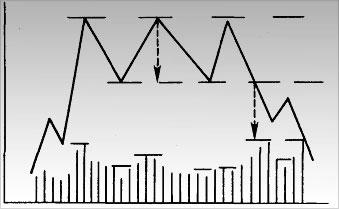
Pic. 5. Triple top. It seems like head-and-shoulders pattern with an exception of all three peaks are at the same level. Every other peak should be followed by trading volume decrease. Pattern is complete when prices overcome both slopes’ level with attendant volume increase.
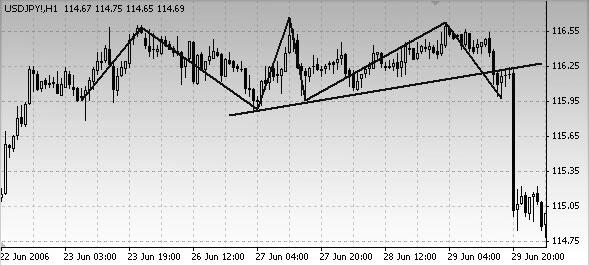
Pic. 6. Triple top of reversal pattern. Pay attention to the three peaks formed in June. Take notice of how support level turns into resistance level after the break down.
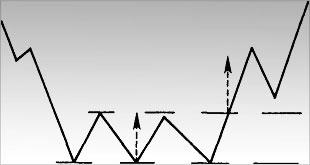
Pic. Triple bottom. It is analogous of inverse head-and-shoulders pattern with an exception of all three slope are at the same level. It is mirror reflection of triple top model with the only difference of volume as confirmative factor being more important while the break upwards.
DOUBLE TOP AND DOUBLE BOTTOM
This reversal pattern is more widespread than the previous one. It is the most familiar after the head-and-shoulders model (pic. 8). At the pictures 8 and 10 top and bottom pattern are drawn. Pay attention that double top model resembles letter “M” by contour and the double bottom resembles “W” letter. They are called this way often. General characteristics of the double pattern agree with characteristics of head-and-shoulders pattern and triple top with an exception of two peaks instead of three. Volume changes led to the double top formation, and the way of its assessment are similar to those we considered above.

Pic. 8. Double top example. This pattern has three peaks (points A and C at the chart), they both are at the same level. Pattern is complete when closing prices overcome slope level B, placed between two peaks. As a rule the second peak C is followed by less trading volume but in break point D volume increases. While pickup stripping prices can rise up to the bottom line.
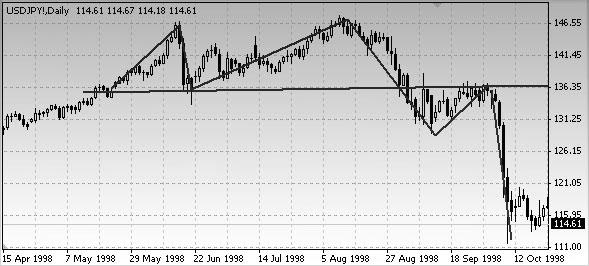
Pic. 9. Double top example. Pay attention to the fact that peaks are almost at the same level, while the real interpretation of the pattern price level difference is acceptable and even desirable because ideal models are seldom When closing prices crossed the level 136.35 model was complete. Support level after the break down turn into resistance level which is one more proof of pattern’s completion and strong signal for short positions opening.
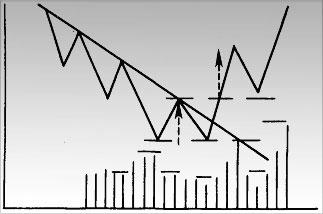
Pic. 10. Double bottom example. It is mirror image of double top pattern. However as it was before volume is very important for the break upwards. Reverse price movement is more typical for bottom models.

Pic. 11.Example of double bottom pattern. Pay attention to the sharp delineated double bottom. When closing prices broke through the pull back level pattern was complete and reverse to the uptrend occurred. Back motion confirmed conversion of resistance level to support level which gave a strong signal to the long positions opening.
As it was mentioned above all these models are just variants of head-and-shoulders pattern so trading tactic is the similar - long and short positions opening is executing only after breakthrough the neckline, when pattern is completed. The strongest signal confirming pattern formation completion, and defining the moment of positions opening is rebound from the neckline after testing it as a result of backwards motion. Now let us dwell upon the notion of price guidepost which was mentioned during the lecture. There is a method of price levels assessment which is reached by market after formation of these models is completed.
This method is based on the height of the model. So let us measure the height from the maximal point of head to the neckline. Then protract the found length down from the break through point of the neckline. Let us suppose that peak point of the head is at the level 100, and the neckline is at the level 80. Consequently, the length of segment will be equal to their difference, i.e. 20. Let us protract 20 pips downwards from the break through point of the neckline and we get the minimum price guidepost where the market will come, it will be level 60. This method is universal for all considered patterns (it is taken the middle point between two peaks or slopes to the neckline).
V-SHAPED PATTERNS OR SPIKES
The last reversal pattern which we will talk about is characterized by the difficulty of its recognition in the period of formation but it occurs often. In fact V-shaped top or bottom (they are also called spikes) are hardly recognizable because they are not patterns in every sense of the word. All the models we were learning before, reflects gradual changes in trend dynamics. Prices are vacillating some time in the framework of horizontal trading “corridor”. Analyst can examine market dynamics in this period, make a forecast about its future, try to find some tips in past or present. Almost all the reversal patterns forms by this scenario. All models except of V-shaped ones. There is no hint upon gradual change in trend dynamics. Turning point of trend occurs quickly, often without any warning signal. This fracture is followed by sudden and very fast price movement to opposite direction. V-shaped pattern can be hardly called model because estimate it or understand that it really took place, we can only post factum. So what should trader do? How can he foresee such models, recognize them in formation process and take measures? To answer all this question let us first examine V-shaped top pattern (pic. 12)
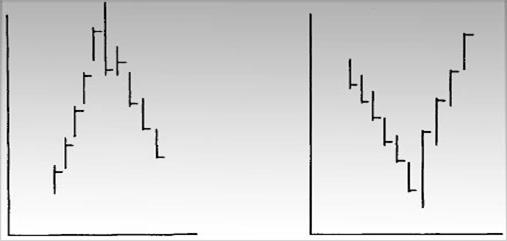
Pic. 12. Example of V-shaped tops.
First of all we have previous trend. Often V-shaped fracture precedes by the swift market development, there is no intermediate corrections or only insignificant. As a rule there are several price gaps in the dynamic of such trend. It seems like market situation goes out of control, market overcome all the possible and impossible expectations. Here experienced know: here he should keep his eyes open.
The main precondition for V-shape reversal or spike is having steep or swift trend. Sometimes the only signal pointed upon the trend reversal is breakthrough the unusual swift trend. Falling following after the reversal, reflects as a rule previous uptrend (one third or 50 %), and it occurs for a short period of time. The main reason of sudden movement to the opposite side is absence of support and resistance levels of previous trend (because it does not have intermediate adjustments). V-shaped models appear as on top as well as on the bottom of the market, the brightest examples are character for the top.
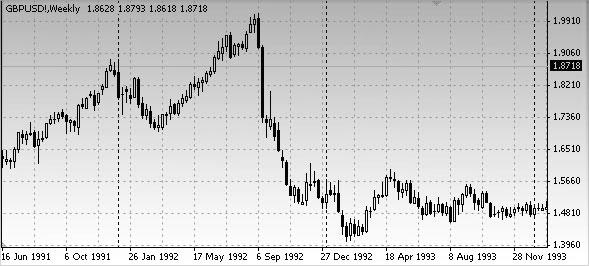
Pic. 13. V-shaped pattern on the top
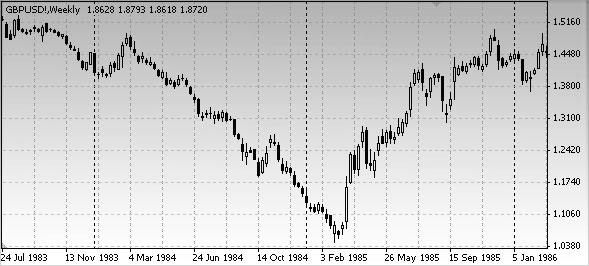
Pic.14. V-shaped model on the bottom of the market
We considered the most widespread major reversal patterns: head-and-shoulders pattern, double and triple tops and bottoms and V-shaped pattern, or spike. As a rule this patterns give signal about the fracture of existing trend formation. That is why they are called “major reversal patterns”. However there is one more set of models which are briefer by nature and indicates not about the reversal trend but about consolidation. And their name is: continuation pattern”. They will be considered in the second part of this lecture.
Test questions
- Find and note the reversal pattern “head-and-shoulders” on the chart, indicate its timeframe and currency pair, and also indicate maximum levels of this pattern. (For instance, head maximum – 1.2530, neckline – 1.2400, etc.). Send the screenshot of the chart.
- After what event reversal pattern double top is completed and when signal for position opening appears.
- Let us suppose that maximal point of the triple top pattern is on the level 1.8050, neckline break through was in the point 1.7990 – figure out the price guidepost which is the price will go down to.
- Indicate the reason of the swift back movement while the spike model formation.
The list of recommended literature
 English
English  Arabic
Arabic 